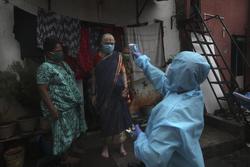 Health workers screen people for COVID-19 symptoms at a slum in Mumbai, India, July 14, 2020. (RAFIQ MAQBOOL / AP)
Health workers screen people for COVID-19 symptoms at a slum in Mumbai, India, July 14, 2020. (RAFIQ MAQBOOL / AP)
India has embarked on a strategy of aggressive testing and guided home isolation of the asymptomatic patients in some provinces as it tries to contain the rising cases of COVID 19 infections and the need to open more sectors of the economy.
There were 45,720 new cases reported in the past 24 hours, according to federal health data released on July 23. India has reported over 1.2 million cases overall, behind only the United States and Brazil. Reports of 1,129 new deaths take its total to 29,861, passing Spain to rank seventh globally in deaths on Wednesday.
India is conducting an average of 300,000 tests country-wide in a day. Till now, 19 million tests have taken place
While they point out that the death rate per 10,000 people is still a low 0.15, compared with 3.97 in the United States and 6.65 in Britain, government officials and experts have called for measures aimed at containing the pandemic in the world's second most populous country.
The latest official missive from the Federal Health Ministry said the "prevalence of COVID 19" has been increasing in the country and opening of the various sectors of the economy is posing a further "challenge".
READ MORE: Bollywood legend's virus infection lays bare India's inequities
India is conducting an average of 300,000 tests country-wide in a day. Till now, 19 million tests have taken place. Though the national capital Delhi, once a hotspot, is now reporting less than 1,000 cases a day, many states continue to remain challenges for the administration when it comes to addressing the spread of the pandemic.
The Western state of Maharashtra is reporting an average of 8,000 cases in the past five days, taking the tally to 318,695, the highest for an Indian state so far.
Aggressive testing is necessary to bring down the national COVID-19 positivity rate; the aim is to maintain this level of testing to bring down positivity rate below 5 per cent
Rajesh Bhushan, official at the federal Health Ministry
"Aggressive testing is necessary to bring down the national COVID-19 positivity rate; the aim is to maintain this level of testing to bring down positivity rate below 5 per cent" Rajesh Bhushan, an official at the federal Health Ministry said.
The national positivity rate of COVID-19 is the average rate of samples testing positive for the disease across the country and it now stands at 6.73 per cent. The rate can provide insights into whether enough tests are being done in a particular area or in a community.
"In a vast country such as India, we learn a lot of things about fighting the pandemic over a period of time. This includes arriving at the best coordination mechanism among multiple administrative agencies, sensitizing people and ensuring that we don't deviate from the basic protocol of test, trace and treat", said Amar Bodhi a medical doctor who has been at the frontline in the region of Delhi since April.
ALSO READ: India cancels historic Hindu pilgrimage as virus cases mount
In April Delhi used to get 3,000 cases from 6,000 tests. "Now we do 22,000 tests across the state a day and the cases have come down to less than 1,000. And we have seen fear-factor among the people giving way to a better understanding as to how to handle the situation,” he said.
“The home isolation of asymptomatic patients proves to be ideal way to deal the situation considering the huge stress a pandemic brings to modest health infrastructure in many parts of the country."
The government of Uttar Pradesh, India's most populous state, which is home to 200 million people, decided to allow home isolation for asymptomatic COVID-19 patients under certain conditions.
India had used lockdown as a containment strategy. But the need to balance between fight against the pandemic and people finding their means of livelihood are now forcing provincial administrations to be very cautious while imposing total shutdown.
The government of Uttar Pradesh decided to allow home isolation for asymptomatic COVID-19 patients under certain conditions
After announcing a week-long lockdown in Bengaluru, the home to India's major Information Technology companies, to check rising cases of COVID-19 from July 14 to 22, state chief minister BS Yediyurappa said in a televised speech address on July 21 “lockdown is not a solution”. The focus should be on "the economy and to help rebuild livelihoods," he said.
Global Economic Prospects report by the World Bank released last week predicted that India’s GDP would contract by 3.2 percent in 2020-21. The country's economy grew 4.2 per cent in 2019-20, the slowest in 11 years.
India announced an economic package $295 billion to revive the economy. The measures it had announced included more spending on healthcare, cash transfers to lower-income households, and deferral of tax payments, and loans for small businesses.
But the pandemic have hit sectors that have employed people in large numbers such as construction and tourism. Moreover, in the wake of the pandemic, thousands of migrant workers who were driving the economic activities in the urban centers had gone back to their homes in rural India.
Experts believe the immediate challenge before the government is to come up with specific measures that will address rural distress and bring more investments.
"Rural incomes will have to be supported and a significant expansion of the government's employment guarantee scheme and allowing more job days would be a good first step,” said Benston John, assistant professor of Economics at St Stephen's college in Delhi.
The writer is a freelance journalist based in Delhi.


